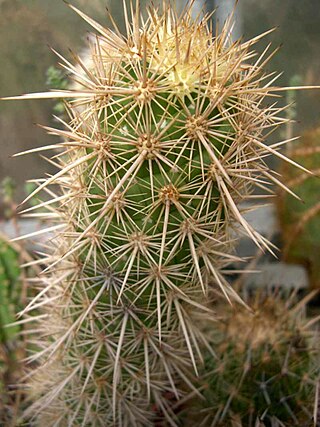
Echinocereus poselgeri, also known as the dahlia cactus, is a species of Echinocereus. It is native to Coahuila and southern Texas.

Cochemiea conoidea, common name Texas cone cactus or Chihuahuan beehive, is a species of cactus native to southern United States to central Mexico.

Cochemiea mainiae is a species of cactus in the subfamily Cactoideae, with the common name counterclockwise nipple cactus.

Thelocactus hexaedrophorus is a species of cactus. It is endemic to Mexico.

Ferocactus gracilis, the fire barrel cactus, is a species of Ferocactus from Northwestern Mexico. This cactus gets its common name from the striking red coloration of its defensive spines and flowers.

Cochemiea poselgeri is a species of Cochemiea found in Mexico

Cochemiea hutchisoniana is a species of Cochemiea found in Mexico.

Cochemiea setispina is a species of Cochemiea found in Mexico.

Cochemiea armillata is a species of Cochemiea found in Mexico.
Cochemiea cerralboa is a species of Cochemiea found in Mexico.

Cochemiea halei is a species of Cochemiea found in Mexico.

Cochemiea phitauiana is a species of Cochemiea found in Mexico.

Echinocereus barthelowianus is a species of cactus native to Mexico.

Echinocereus brandegeei is a species of cactus native to Mexico.

Echinocereus ferreirianus is a species of cactus native to Mexico.

Echinocereus maritimus is a species of cactus native to Mexico.

Echinocereus nicholii is a species of cactus native to Mexico.

Echinocereus ortegae is a species of cactus native to Mexico.

Echinocereus pamanesii is a species of cactus native to Mexico.

Echinocereus schereri is a species of cactus native to Mexico.




















